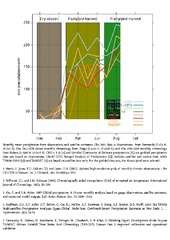| dc.contributor.author | Schwinger, Catherine | en_US |
| dc.contributor.author | Lunde, Torleif Markussen | en_US |
| dc.contributor.author | Andersen, Peter | en_US |
| dc.contributor.author | Kismul, Hallgeir | en_US |
| dc.contributor.author | Van den Broeck, Jan | en_US |
| dc.date.accessioned | 2014-11-18T15:29:21Z | |
| dc.date.available | 2014-11-18T15:29:21Z | |
| dc.date.issued | 2014-11-18 | eng |
| dc.identifier.issn | 2194-6434 | |
| dc.identifier.uri | https://hdl.handle.net/1956/8760 | |
| dc.description.abstract | Background: Studying the influence of geographical factors on child growth is important, especially given the increasing interest in climate change and health in resource-poor settings and the recognized importance of growth faltering as a general marker of population health. We describe patterns in children’s weight and length velocity and relate them to seasonal and spatial factors in rural DR Congo. The study setting is a food-insecure area with a majority dependent on rain-fed subsistence farming and expected to be one of the regions most affected by climate change. Methods: We studied the effect of selected geographical factors, i.e. season, village size and distances to hospital, health center, forest, fishing grounds and market on growth of children under two years old. We calculated individual growth velocity Z-scores according to the WHO-2009 growth velocity standards for up to five successive 3-month growth periods. Associations with geographical factors were examined in multivariate mixed effects regression models. Results: For the study population of 2223 children is characterized by low nutritional status. Age and season were the only independent predictors of growth velocity in the multivariate regression analysis. Mean velocity Z-scores were already low in children aged 0-6 months for weight [-1.34 (95% CI: -1.45, -1.22)] and for length [-0.99 (95% CI: -1.13, -0.84)]. They increased with age, while Z-scores of attained growth gradually decreased. Mean growth velocities were lowest before the main harvest season with a mean improvement of 1.2 and 2.3 Z-scores for weight and length velocity thereafter. A seasonal pattern was not seen in attained growth. No relation to spatial factors was found. Conclusions: In this rural subsistence economy area, geographical factors relating to distances to food sources and health services are less important determinants than harvest season, which is the major underlying determinant of child growth in these settings. | en_US |
| dc.language.iso | eng | eng |
| dc.publisher | Springer | eng |
| dc.relation.ispartof | <a href="http://hdl.handle.net/1956/17271" target="blank"> Growth velocity of young children in two low-resource settings. Patterns and abilities to predict negative health outcomes</a> | |
| dc.rights | Attribution CC BY | eng |
| dc.rights.uri | http://creativecommons.org/licenses/by/4.0 | eng |
| dc.subject | Ecological factors | eng |
| dc.subject | Growth velocity | eng |
| dc.subject | Anthropometry | eng |
| dc.subject | Climate | eng |
| dc.subject | Nutritional status | eng |
| dc.title | Seasonal and spatial factors related to longitudinal patterns of child growth in Bwamanda, DR Congo | en_US |
| dc.type | Peer reviewed | |
| dc.type | Journal article | |
| dc.date.updated | 2014-11-17T20:03:42Z | |
| dc.description.version | publishedVersion | en_US |
| dc.rights.holder | Catherine Schwinger et al.; licensee BioMed Central Ltd. | |
| dc.rights.holder | Copyright 2014 Schwinger et al.; licensee Springer | |
| dc.source.articlenumber | 26 | |
| dc.identifier.doi | https://doi.org/10.1186/s40322-014-0026-8 | |
| dc.source.journal | Earth Perspectives | |
| dc.source.40 | 1 | |


